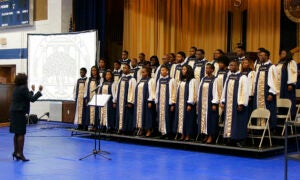Give Ear To My Word: Stillman’s Great Ambassador
Stillman College, the historically Black college founded in 1870, has an ambassador extraordinaire: its choir, which tours across the country and often brings its audiences to tears. Its performances have changed lives.
Bob Herrema still remembers a performance of the Messiah in 1969, when he and a fellow church member organized a combined performance, with the Stillman Choir and string students from the University of Alabama. Before Herrema raised his baton, he turned to look at the audience – and saw Stillman’s Brown Chapel filled with faces of all colors. Before the performance was over, some would be in tears.

“Stillman turned out to have an impact for the rest of my life,” he says. Herrema, who is white, had arrived at the school to take the job knowing how good the music of the Black tradition was. He left knowing how easily people could connect across race through music, and how much they would be moved by the connection. For the rest of his long career as a professor and a chorus leader, most of it in Pennsylvania, he incorporated composers like Moses Hogan in the repertoire.
The choir’s power has resonated many times over the years for others, says Jocqueline Richardson, an alumna and the choir’s director. “When we sang Somebody’s Praying – when we sang that in St. Charles, a church that was in Hurricane Katrina, you understand, the members were crying.”
There are about 40 choir members; a more select group tours each year. Richardson ticks off other performances that were meaningful, including one in the church where former Secretary of State Condoleeza Rice is a member. The choir’s tour of churches near San Francisco included performances of the Battle Hymn of the Republic, O Freedom, and I ain’t gonna let nobody turn me around, among others.
The repertoire, she believes, is key. It consists of, among many others, Handel’s Messiah and Ernani Aguiar’s Salmo 150, and spirituals arranged by William Dawson and Moses Hogan. The choir has the diction, talent and passion to move across the traditions and give each one equal weight.
Charlie Mitchell, a student in the 1970s, went on to get a PhD in music and became a music leader, now in Louisville, Kentucky. Herrema remembers him as a tall, lanky young man, with his sleeves too short. “I found him at the piano one day, saying “This is the music I want to play,” remembers Herrema, who introduced the choir to such hymns as Give Ear To My Word – a phrase Mitchell remembers to this day as foreign to his.
Watch the Stillman Choir perform at Westminster Presbyterian Church – Birmingham, Ala., February 3, 2019
Today, Mitchell, who is an organist, plays Bach in the same performances as Ulysses Kaye. At a performance in southern Indiana, he focused on the work of composers from the African diaspora, such as Ulysses Kaye, Florence Price and Fela Sowanda. A nationally known organist came up to him afterwards, and somewhat stiffly, but warmly, said the concert had been “well received.”
“I figured I’d arrived then,” says Mitchell with a laugh. “I grew up on a farm in rural Alabama. My people were farmers. The choir at Stillman and the touring we did … singing in those churches, listening to the organ, showed me what you could do with music.”